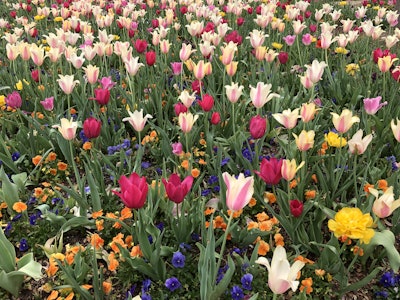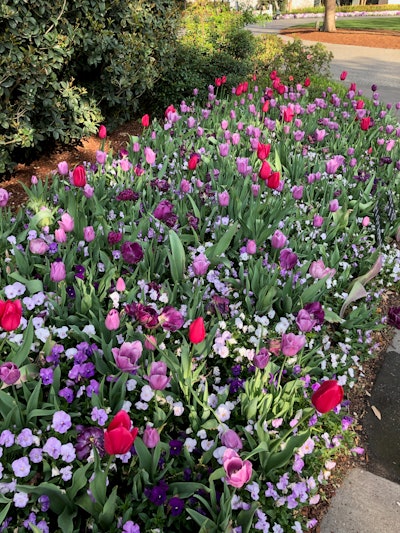 Photo: Jill Odom/Total Landscape Care
Photo: Jill Odom/Total Landscape CareWith fall just around the corner, now is the time to get inspired because this is prime time to plant bulbs. Come spring, your client’s garden will turn into a backyard of blooms.
Because bulbs have a season before anything is seen, there is a sense of heightened anticipation and therefore more care should be taken when selecting and planting. Sure, some haphazard tulips and daffodils may please some folks, but, as a professional, you should challenge yourself and take your fall planting to another level.
Just like any good artist, think of your client’s fall beds as blank canvases and practice the principles of art.
Follow a theme
The style of the house and the rest of the backyard should be taken into consideration when deciding how to group the bulbs. If it is a casual landscape design, go with a more natural look by placing them in irregular groupings. For a more formal look, plant one type of bulb in rows along a path for uniformity.
Along with how the flowers are grouped, you can also play around with the color palette, as a painter would. Pick shades within one color family to play up the surrounding area or for contrast with nearby plants. There’s also the option of going with a monochromatic scheme, which provides emphasis rather than color.
Implement rhythm
Just like how a repeating beat in a song is the reason why it is so catchy, using the same grouping of plants in multiple areas makes the space feel more cohesive.
“Our eyes connect to these similar shapes or colors in one scene rather than a collection of separate elements,” said Marlene Thompson, creative director at Longfield Gardens.
Scatter groups of the same type and color of bulb throughout the landscape to create a greater visual impact. It also makes care easier since they will all have the same needs.
Add some variety
Practice common sense and mix up the bloom times for the bulbs you are choosing. Start with early spring bloomers like narcissus and glory-of-the-snow and layer in midseason and late season bulbs to provide color for as long as possible.
Sprinkle in some perennials that will peak later on in the season and block out the dying leaves of the bulbs. Evergreens can also be used to mix it up and planting them near these shrubs will make the spring blossoms stand out even more.
Provide proportion
 Use varying heights to provide proportion.
Use varying heights to provide proportion.Photo: Jill Odom/Total Landscape Care
By layering small, medium and large bulbs on top of each other, the varying heights provide a beautiful double-decker effect of multiple blossoms. A good example of a layered section would be to use alliums first, then hyacinths and finish with crocuses.
Another option is to plant bulbs in front of or behind one another. Generally, it is a good rule of thumb to plant the low bulbs in front of the high ones. However, if the taller bulbs bloom after the low bulbs, it’s a good idea to plant the tall ones up front to hide the dying remains of the short bulbs.
So, as you begin to bury the bulbs, keep these principles in mind, but remember that your creativity helps make any design possible.











